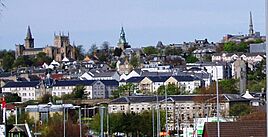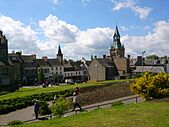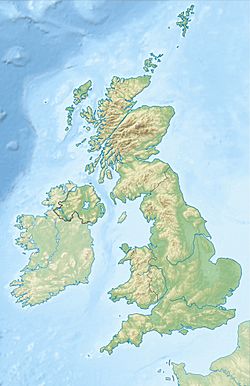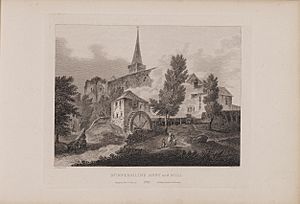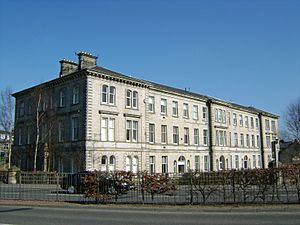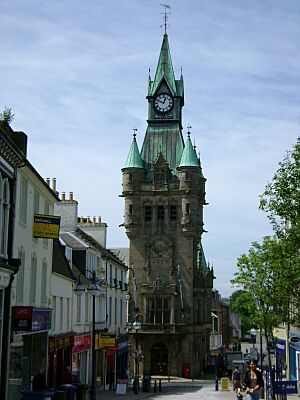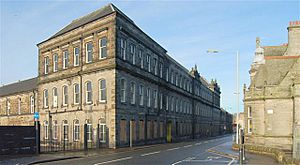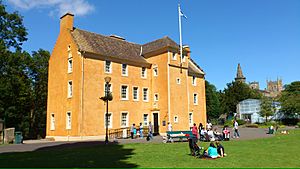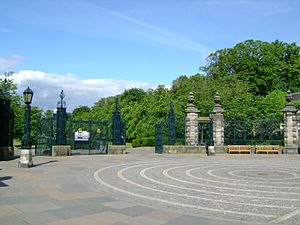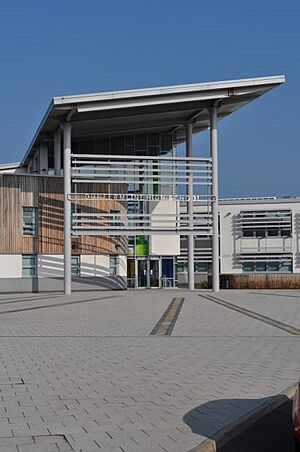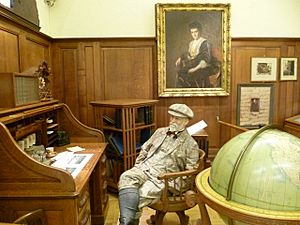Dunfermline facts for kids
Quick facts for kids
Dunfermline
|
|
|---|---|
|
|
|
| Nickname(s):
Auld Grey Toun
|
|
| Lua error in Module:Location_map at line 420: attempt to index field 'wikibase' (a nil value).
Location within Fife
|
|
| Sovereign state | United Kingdom |
| Country | Scotland |
| Council area | Fife |
| Lieutenancy area | Fife |
| Area | |
| • Locality | 7.7 sq mi (19.9 km2) |
| • Urban | 11.1 sq mi (28.8 km2) |
| Population
(2020)
|
|
| • Locality | 54,990 |
| • Density | 7,157/sq mi (2,763/km2) |
| • Urban | 76,210 |
| • Urban density | 6,854/sq mi (2,646/km2) |
| • Language(s) | English Scots |
| Postcode areas |
KY11, KY12
|
| Area code(s) | 01383 |
| OS grid reference | NT105875 |
Dunfermline (pronounced dun-FURM-lin) is a city in Fife, Scotland. It's about 3 miles (5 km) from the northern shore of the Firth of Forth. For a long time, from the 11th to the 15th centuries, Dunfermline was like the unofficial capital of Scotland.
The first people lived here way back in the Neolithic (New Stone Age) period. The city was first written about in the 11th century. This was when Malcolm III of Scotland, a Scottish king, married Saint Margaret in Dunfermline. Queen Margaret started a church, which later became Dunfermline Abbey in 1128. This Abbey became a very important burial place for Scottish kings and queens. Many royals, including seven kings like Robert the Bruce, were buried here between 1093 and 1420.
In the 1700s, Dunfermline became a strong economic center because of the linen industry. Famous people like Andrew Carnegie, a very successful businessman, came from here. Dunfermline officially became a city in 2022. This was part of Queen Elizabeth II's Platinum Jubilee Civic Honours. Today, it's a big service center. Major companies like Sky UK, Amazon, and Lloyds have offices here. Dunfermline is also on the Fife Pilgrim Way, a walking route. The city has about 58,508 people, and the wider area has around 76,210 residents.
Contents
- History of Dunfermline
- How Dunfermline is Governed
- Dunfermline's Geography
- People of Dunfermline (Demography)
- Dunfermline's Economy
- Famous Buildings and Places
- Culture and Fun
- Media in Dunfermline
- Sports in Dunfermline
- Education in Dunfermline
- Public Services
- Transport in Dunfermline
- Famous People from Dunfermline
- Twin Cities
- Images for kids
- See also
History of Dunfermline

Ancient Times in Dunfermline
The name "Dunfermline" has been thought about in different ways. The first part, "dun," means a "fortified hill" in Gaelic. This probably refers to the rocky hill where Malcolm Canmore's Tower once stood in Pittencrieff Glen. The rest of the name is a bit of a mystery.
People first lived in the Dunfermline area during the Neolithic period. Tools like stone axes and flint arrowheads have been found. By the Bronze Age, the area was becoming more important. Bronze axes and gold jewelry have been discovered. Ancient burials from the Bronze Age have also been found nearby.
The first official record of Dunfermline was in the 11th century. A writer from the 1300s, John of Fordun, said that King Malcolm III married Princess Saint Margaret here. This wedding happened between 1068 and 1070. Malcolm III made Dunfermline a new center for royal power. It became Scotland's main capital for much of the time until 1437. Queen Margaret encouraged her husband to build a bigger church for monks. This new church was started around 1072.
Dunfermline: Scotland's Capital
King David I of Scotland (who ruled from 1124 to 1153) later gave this church to monks. It became Dunfermline Abbey in 1128. The Abbey was very important in changing religion across Scotland. It became a rich and powerful place. Many Scottish royals were buried here, from Queen Margaret in 1093 to Robert Stewart in 1420.
Robert The Bruce (who ruled from 1306 to 1329) wanted to be buried in Dunfermline. He was the last of seven Scottish Kings to be buried there in 1329. His heart, however, was taken to Melrose Abbey.
Dunfermline became a town between 1124 and 1127. Dunfermline Palace was also connected to the Abbey. An important agreement called the Auld Alliance was signed there in 1295.
Prince Charles, the son of King James VI of Scotland, was born in Dunfermline Palace in 1600. But when King James VI became King of England too in 1603, he moved the royal court to London. This ended Dunfermline's time as a royal center. King Charles was the last monarch born in Scotland. In 1624, a big fire destroyed about three-quarters of the town. Luckily, the palace, the abbey, and the Abbot's House survived.
Modern Dunfermline
Dunfermline's luck changed in the early 1700s when the linen industry started. The town had enough water to power the mills. Nearby ports also traded with countries around the Baltic Sea. A weaver named James Blake learned the secret to making damask linen in 1709. He then started a damask linen industry in Dunfermline in 1718. St Leonard's Mill, built in 1851, was the biggest factory. After the First World War, the linen industry declined. In 1909, the Royal Navy built Scotland's only Royal Naval Dockyard nearby at Rosyth.
After World War II, new homes were built in areas like Kingseat and Townhill. More council housing was built in Abbeyview, Touch, Bellyeoman, and Baldridgeburn. Private homes were built north of Garvock Hill.
Dunfermline has grown a lot since 1999, especially on its eastern side. New neighborhoods like Duloch and Masterton have been built. These include over 6,000 homes, new schools, and the Fife Leisure Park. This growth has made the town's population increase by more than 20% in 15 years. Fife Council plans to expand the town even more.
Today, Dunfermline is the main center for West Fife. It's also a "dormitory town" for Edinburgh, meaning many people live here and travel to Edinburgh for work. The town has shops, a large public park, a college campus, and a leisure park with a cinema. Amazon.com opened a huge warehouse here in Duloch Park.
On May 20, 2022, Dunfermline was officially given "city status" as part of the Queen's Platinum Jubilee. It formally became a city on October 3, 2022.
How Dunfermline is Governed
Dunfermline used to be a "royal burgh" until 1975. Then, it became part of the Dunfermline District. This district was one of three in the Fife region. In 1996, the district council was removed. Now, Fife Council is in charge of the whole area.
Today, Dunfermline has different levels of government. Community Councils, like Abbeyview and Central Dunfermline, are the lowest level. They share local opinions with bigger governments. Fife Council is the main local authority for Dunfermline. They handle local services and decisions. Dunfermline still has an important role as an administrative center. The council's main West Fife office is at New City House. Meetings for the City of Dunfermline Area Committee happen in the Dunfermline City Chambers.
Dunfermline is part of the Dunfermline and West Fife area for the UK Parliament. This area chooses a Member of Parliament (MP) to go to the House of Commons in London. The current MP is Douglas Chapman. For the Scottish Parliament, Dunfermline is part of the Dunfermline area. This area chooses a Member of the Scottish Parliament (MSP) to go to the Scottish Parliament in Edinburgh. The current MSP is Shirley-Anne Somerville.
Dunfermline's Geography
Dunfermline is located at 56°04′17″N 3°27′42″W / 56.07139°N 3.46167°W on the edge of Fife's coast. The old town was built on land that rises from about 167 feet (51 meters) above sea level in the south. It goes up to 344 feet (105 meters) higher up the High Street.
Temperatures in Dunfermline are usually mild, like the rest of Scotland. Fife is a peninsula, surrounded by water on three sides. This means summers are cool, and the water helps keep winters warmer. The average yearly temperatures in Dunfermline range from a high of 64°F (18°C) to a low of 48°F (9°C).
The Cleish Hills separate the town from the area to the north.
People of Dunfermline (Demography)
In 2011, Dunfermline had a population of 49,706 people. By 2012, this number grew to 50,380. There are about 21,620 homes in Dunfermline, and most of them (70.7%) are owned by the people living in them. The largest age group in Dunfermline is people aged 30 to 44.
In 2016, the total population in the wider Dunfermline area was about 55,451. This number is expected to grow by 29% by 2026. About 77% of homes in the area are owner-occupied.
Dunfermline's Economy
For a long time, starting around the 1400s, coal and limestone were mined near Dunfermline. At first, this was on a small scale. As farming improved, more lime was needed for the land. This meant more coal was needed to burn the lime. Salt making also used a lot of coal. When coal near the Firth of Forth ran out, mining moved further inland, often within Dunfermline itself.
Moving the minerals from the mines to the Forth was hard. Dunfermline was one of the first places to build wooden "waggonways" for this. Over time, these became railways. They usually ran from north to south, taking minerals to ports like Charlestown and Limekilns. Later, modern railways connected Dunfermline from east to west.
During the Industrial Revolution, industries in Dunfermline were mainly around Pilmuir Street and along the Lynn Burn. Textile factories were very important. After World War II, older industries like linen and coal mining slowly disappeared.
However, manufacturing came back in the 1960s. New factories opened, and business parks like Pitreavie Business Park were built.
The Dunfermline area has the most jobs in Fife, with about 26,600 jobs in 2009. The biggest job areas are shops and retail, health and social work, and information and communication. There are also jobs in finance, manufacturing, and food services.
Some big employers in Dunfermline include Best Western (hotels), Sky UK (TV and internet), CR Smith (windows), FMC Technologies (energy), Lloyds, and Nationwide (both banks). In 2011, Amazon.com opened a huge warehouse in the east of the town. This created over 750 jobs and is Amazon's largest warehouse in the UK.
Dunfermline is the main shopping center for West Fife. Most shops are in the town center along the high street. The Kingsgate Shopping Centre has both modern and traditional shops. Other shopping areas are at Carnegie Drive Retail Park and Halbeath Retail Park. The Fife Leisure Park, built in 1999, has a large cinema, a health club, a bowling alley, and many restaurants.
Famous Buildings and Places
The Dunfermline Abbey is a very old and important building. It was built between 1128 and 1150. It was a new version of an older chapel started by Queen Margaret. Even though parts were destroyed in 1303, much of it still stands. The Abbey church was built between 1818 and 1821 on the site of the old church.
The main Dunfermline War Memorial on Monastery Street was opened in 1925. It remembers 632 people who died in the First World War and 275 in the Second World War.
Near the abbey is the Abbot House. This is the oldest non-religious building in Dunfermline. It was built in the mid-1400s for Abbot Richard Bothwell.

The Dunfermline Carnegie Library was built between 1881 and 1883. This library was the first in the world to be paid for by Andrew Carnegie. He was a rich businessman and gave money for 2,811 free public libraries around the world. Andrew Carnegie's birthplace, a handloom weaver's cottage, is also nearby. A special hall was added to it in 1928.
The Dunfermline Guildhall on the High Street was built in 1807. The City Chambers, with its tall clock tower, was built between 1876 and 1879.
In a car park, you can find St Margaret's Cave. This was a quiet place where Queen Margaret would go to pray. It was reopened in 1993. The beautiful Louise Carnegie Memorial Gates, also called the Glen Gates, lead into Pittencrieff Park. They opened in 1929 and were named after Andrew Carnegie's wife. Inside, there's a bronze statue of Andrew Carnegie.
Inside Pittencrieff Park is Pittencrieff House, built around 1610. It was turned into a museum and art exhibition space. The house was recently repaired and looks like its original ochre (yellow-orange) color.
There are also grand homes outside the town. Pitfirrane Castle, from the 1500s, is now a clubhouse for Dunfermline Golf Club. Hill House and Pitreavie Castle are from the mid-1600s. Logie House is an Edwardian home.
Other buildings funded by Andrew Carnegie include the Carnegie Leisure Centre and the Carnegie Clinic.
Culture and Fun
Pittencrieff Park covers 76 acres (31 hectares) and is on the western edge of the town center. Andrew Carnegie gave it to the people of Dunfermline in 1903. Locals call it the Glen. The park is being improved with money from the Heritage Lottery Fund.
The Bruce Festival is a yearly event held in Pittencrieff Park in August. It celebrates Robert The Bruce's connection to Dunfermline. It has a medieval village, food, and battle re-enactments.
The Andrew Carnegie birthplace museum tells the story of the famous businessman. It includes his birthplace cottage and a hall about his life.
In 2017, the Dunfermline Carnegie Library & Galleries opened. It's an extension of the old Carnegie library. It has a museum, art gallery, archives, library, cafe, and gardens. This building has won awards for its design.
Dunfermline has two theaters: Carnegie Hall and the Alhambra. Carnegie Hall hosts plays and music shows. The Alhambra reopened in 2008 for live music and theater. The 'Kinema Ballroom' has been a famous music venue and nightclub since 1938.
Local groups include the Dunfermline Folk Club and the Dunfermline Abbey Choir. Dunfermline Fire Station, an old building, is now an arts venue, cafe, and studio.
Media in Dunfermline
You can get TV signals from the Craigkelly or Black Hill transmitters.
Radio West Fife is one of Scotland's oldest hospital radio stations. It broadcasts to the Queen Margaret Hospital.
Other radio stations you can listen to include BBC Radio Scotland, Forth 1, Kingdom FM, and Greatest Hits Radio Scotland.
The Dunfermline Press is the town's weekly local newspaper.
Sports in Dunfermline
Dunfermline has a professional football team, Dunfermline Athletic. They play at East End Park in the Scottish Championship. The team won the Scottish Cup twice in the 1960s (1961 and 1968).
The senior rugby team, Dunfermline RFC, plays at McKane Park. Dunfermline Reign is a basketball team that plays in the Scottish Men's National League. Dunfermline Tennis Club plays at Bothwell Street. Their ladies' team has won the Scottish Cup many times.
There's also a cricket club, an athletics ground at Pitreavie, and three golf courses. The Carnegie Leisure Centre is the main sports center. It was recently updated with a new swimming pool and gym.
The Dunfermline Kings are the town's American football team. Running clubs include Dunfermline Track and Field Club. Dunfermline Cycling Club, formed in 1935, is one of Scotland's largest cycling clubs.
Education in Dunfermline
Dunfermline has four secondary schools and fourteen primary schools. There's also a private school and Calaiswood ASN School for children with special learning needs. Dunfermline High School is the oldest secondary school, started in 1816. A new £40 million Dunfermline High School opened in 2012.
Queen Anne High School is in the northwest of the town. Woodmill High School serves the eastern side of the town. St Columba's High, opened in 1969, is a Roman Catholic secondary school for pupils in West Fife.
For further education, there's Fife College. It was founded as Lauder Technical School in 1899 by Andrew Carnegie. He named it after his uncle, George Lauder. The college offers courses to over 10,000 students each year.
Public Services
Fife Council handles waste management in Dunfermline. There's a recycling program for homes. Dunfermline has a recycling center and several recycling points.
Healthcare is provided by NHS Fife. The main hospital for emergencies is Victoria Hospital in Kirkcaldy, about 13 miles (21 km) away. The Queen Margaret Hospital in Dunfermline offers out-patient and day care services.
The Scottish Fire and Rescue Service provides fire and rescue services. The nearest fire station is at the Pitreavie Industrial Estate. Police Scotland handles policing in Dunfermline. Their main office is on Holyrood Place. The Scottish Ambulance Service also serves Dunfermline, with two ambulance stations in the town.
Transport in Dunfermline
Dunfermline is connected by the A907 road, which meets the M90 and A92 motorways. These roads connect the town to Perth in the north, Edinburgh in the south, and Kirkcaldy in the east. The main roads through town are Halbeath Road and Carnegie Drive.
The main bus station is north of the town center. There are also two "Park and Ride" sites nearby at Ferrytoll and Halbeath.
Dunfermline has two railway stations: Dunfermline City and Dunfermline Queen Margaret. There are also nearby stations at Rosyth and Inverkeithing.
The closest major airport is Edinburgh Airport, about 13 miles (21 km) south of Dunfermline.
Famous People from Dunfermline
Dunfermline's most famous person is Andrew Carnegie. He was born here in 1835. He became a very rich businessman and gave a lot of money to his hometown. He funded a free library, public swimming baths, and bought the Pittencrieff Estate to create Pittencrieff Park. His cousin, George Lauder, a top engineer, also came from Dunfermline. In 1888, two men from Dunfermline, John Reid and Robert Lockhart, helped bring golf to the US.
Several Scottish kings were born in Dunfermline Palace. These include David II of Scotland (born 1324), James I of Scotland (born 1394), and Charles I (born 1600). King James VI and his wife, Anne of Denmark, also lived at the Palace.
The 15th-century poet Robert Henryson, an important writer, lived in the town. General John Forbes, who helped capture Fort Duquesne in America, grew up in Pittencrieff House.
John Struthers, a famous anatomist, was born near Dunfermline. The artist Sir Joseph Noel Paton was also born here.
In popular culture, many famous people have come from Dunfermline. These include singer Barbara Dickson; actor Kenneth Cranham; Dan McCafferty and Pete Agnew from the band Nazareth; Ian Anderson from Jethro Tull; and ballerina Moira Shearer. Manny Charlton, Nazareth's producer, moved here as a child. Stuart Adamson of the Skids and Big Country grew up nearby. Film director Richard Jobson also went to school in Dunfermline.
In sports, Caroline Weir plays for Real Madrid and has played over 100 times for Scotland's national football team. Rugby players Harry Lind and Jim Greenwood also came from Dunfermline.
Twin Cities
Dunfermline is connected with these cities around the world:
- Logroño, Spain (since 1990)
- Sarasota, Florida, United States (since 2001)
- Trondheim, Norway (since 1945)
- Wilhelmshaven, Germany (since 1979)
- Vichy, France (since 1990)
- Albufeira, Portugal (since 1995)
Images for kids
See also
 In Spanish: Dunfermline para niños
In Spanish: Dunfermline para niños


